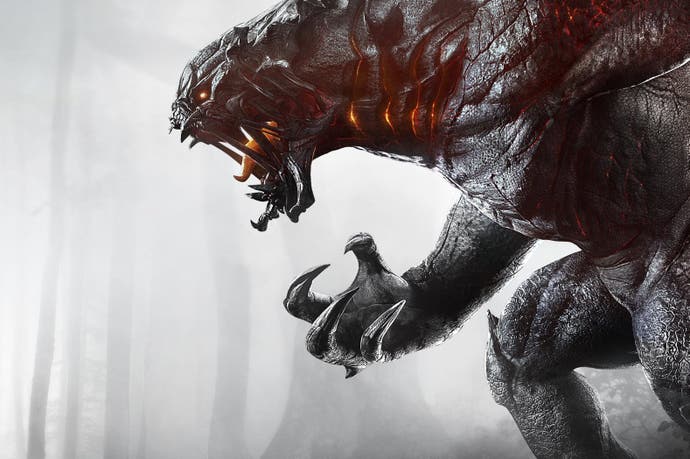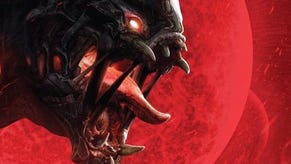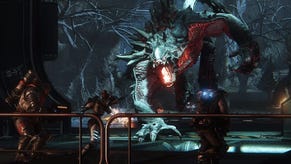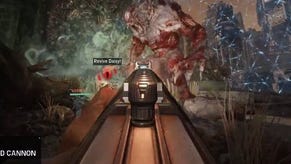Evolve review
Beast mode.
Eurogamer has dropped review scores and replaced them with a new recommendation system. Read the editor's blog to find out more.
Evolve lives and dies by its concept. This isn't a big budget shooter that's happy to just borrow from the rest and coast through unnoticed. Just like its three-storey high behemoths that smash and crash through the game's brittle scenery, Evolve wants you to sit up and take notice. And when it all clicks, you can't help but do just that.
By now, that raw concept has been very well publicised. Four human players drop into an alien jungle to hunt a monster, and that monster just happens to be controlled by a player too. Asymmetrical multiplayer is all the rage, and Evolve is blazing the trail.
The main mode here is called Hunt, and aptly so. Assuming you're playing as a hunter (Evolve's name for non-monster characters), you're dropped into a map as a team of four, and have to track and then destroy the beast before it does the same to you. The monster is relatively weak at first (although still more than capable of eviscerating a poorly organised team), so it's in the hunter's interest to find it quickly, before it devours enough local wildlife to evolve, level up, and destroy the power relay at the centre of each map.
At first, no matter who you pick, it's a tricky concept to get your head around. Each hunter class has to be played in a very specific way, and a team with even a single weak link will be fodder for even a half-decent monster player. So, if you've chosen Assault, you'll really need to take responsibility for doing most of the damage.

The first Assault character, Markov, has a lightning gun that does tremendous harm up close. But getting close to a 20-foot monster isn't typically a very good idea. This is why he has a rechargeable shield so he can dive in, cause trouble, and get out before the beast has a chance to retaliate.
What, though, if the Assault gets stuck in close and starts taking huge damage? Well, he'll need a medic to heal (which can be done from a distance thanks to a healing gun, which fires a constant beam of goodness at its target), but he'll also need the Support to keep an armour-buffing beam locked on as well. All well and good, but what happens if the Support gets attacked? This is the ever-shifting dynamic of Evolve's battles.
A shame, then, that these main event encounters lack punch and power. Yes, the tactical opportunities are plentiful, but it's tough to derive true satisfaction from a well-placed orbital strike or carefully-managed heal when the actual impact of battling the beast feels so hollow. It's a problem with feedback, in that there's very little. Blasting the beast feels little different to blasting a wall; it doesn't react to gunfire and the only way of knowing you're actually doing damage is by watching the health bar go down.
Likewise, playing as the monster should make you feel immeasurably strong and destructive, but your abilities feel tame. The Goliath's leaping attack lacks the kind of crushing crunch you really want it to have; the Kraken's lightning is oddly flimsy. The fights are frantic and dizzying, and the glory that should come from felling these foul beasts is replaced by an on-screen message and a slightly hollow sense of victory.
So it really does come down to how much you value tactics over raw, visceral action. Each class has four abilities, most of which operate on a cooldown. Learning how to play as your class is rewarding, because you can see exactly how you're contributing to battle. Unlocks are tied to your efforts with individual weapons and abilities, so you are forced to experiment and gain a proper comprehension of how to help your team. And matters get much more interesting once you unlock the different hunters in each class, all of which have their own abilities.
The first Trapper, Maggie, brings a Trapjaw (basically across between a dog and an angler fish) with her that tracks the Monster's footsteps and can heal downed characters. The second Trapper, Griffin, doesn't have one. He has sound spikes that you can place around the environment, tagging the monster when he goes near. This completely changes how a team plays, and it's vital that you not only learn your own favourite class, but the intricacies of every character. Once you do, you'll be near enough unstoppable.
That is until you come up against a monster player who knows what they're doing. Whether it's the hulking Goliath, the flying Kraken or the powerful but vulnerable Wraith, there is plenty to study. Much like the Hunter classes, each beast has four abilities, but the efficacy of each can be chosen at the start. You start with three skill points you can attribute to any of the above powers, and each stage of evolution awards you three more.
So, as the Goliath, you might choose to pour all three points straight into his Charge ability, meaning you can clatter through teams of enemies or out of harm's way far more effectively than a monster who has spread his points between breathing fire, chucking rocks and leaping about. You'll find your own preferable monster builds, but as with the Hunters, you'll need to experiment with everything to unlock the later beasts.
Thankfully, with the slow pace of the unlocks and the average length of time in a match (10 minutes plus), you soon start to develop broad tactics. Hunters quickly learn that just blindly following Monster tracks is hopelessly inefficient - splitting into pairs and heading off the beast is instantly more appealing.
And the monsters themselves can use the environment to their advantage. Flocks of birds that scatter when you come close start off as a pain, as they alert the hunters to your presence. Clever players might figure out that they can use them to trick the hunters though. Scatter birds, use the stealth walk to sneak into a nearby cave, then ambush the Hunters when they're searching for you. Any concerns about a lack of depth have already proven unfounded.
Further variety comes from the environments themselves. The planet Shear is an inhospitable joint, and all manner of weird creatures strut about the place. Some are little more than food for the monster, while others are basically monsters themselves - devastating hulks that can decimate a hunter team or cause huge problems for an unevolved monster.
This leads to some great Left 4 Dead-style moments of panic. A lollygagging medic might get snapped up by a carnivorous plant, and can only be freed by a teammate. Not exactly ideal when you've just managed to trap a monster in your energy dome. Even in games where you're spending ages tracking the monster, there are at least things to distract you from just walking forward, bored.

Of course, that is Evolve's greatest concern. In a game of hide and seek, it quickly becomes boring when the hider is just too good at his job (like when my stepdad managed to hide in the airing cupboard for an hour, the strange man). There are games where action is minimal and trudging is near endless. They're much more infrequent than in the Alpha, but this is the danger of committing to the concept.
Thankfully, Evacuation mode does offer an alternative to the thrill - or occasional lack thereof - of the Hunt. Here, three new game types are introduced, as players take on a series of five matches, where the previous result has an impact on the next match. It's great stuff - the world is given colour by the extra banter you'll hear as a hunter, while the new modes do offer new - albeit less tactically complex - ways to play.
Defend is similar to Battlefield's Rush - the hunters must stop the Monster and his AI controlled minions from destroying three sequentially placed bases. Simple, effective, enjoyable. Rescue spawns human survivors across the map, and asks hunters to find them and bring them back to base before the Monsters get them. Again, great fun. And the final mode, Nest, actually plays very similarly to Dying Light's Be The Zombie mode. Hunters have to clear monster eggs from the map, while the beast protects them. None of these modes are as nuanced as Hunt, but Evacuation mode is the perfect way to enjoy the game when you're on for a longer sessions.
In my initial impressions, I posited that Evolve's flame would burn brightly then quickly flicker out. This was perhaps unfair - this is a game that will find a core audience who loves it and plays for years. The concerns about its actual battles, though, have remained. Tactical play is rewarding, regardless of who you're playing as, but Evolve lacks punch and power in its fights. There's something too loose and flimsy when you're involved in what should be a brutal, heavy and crunching melee. It means Evolve floats in a strange limbo, where the foreplay is better than the main event.
This is a shooter with ambition, designed with skill and craft, and rich with tactical possibility. If it had the punch and physical feedback of some of its less-intelligent genre mates, Evolve could have been a classic. As it is, we'll have to do with a monster with plenty of bark, but not quite enough bite.










